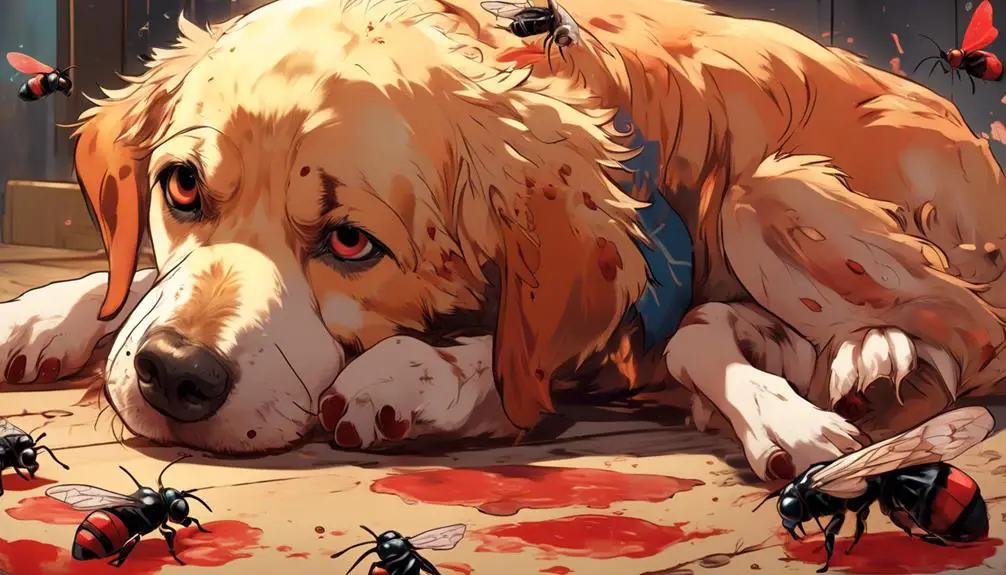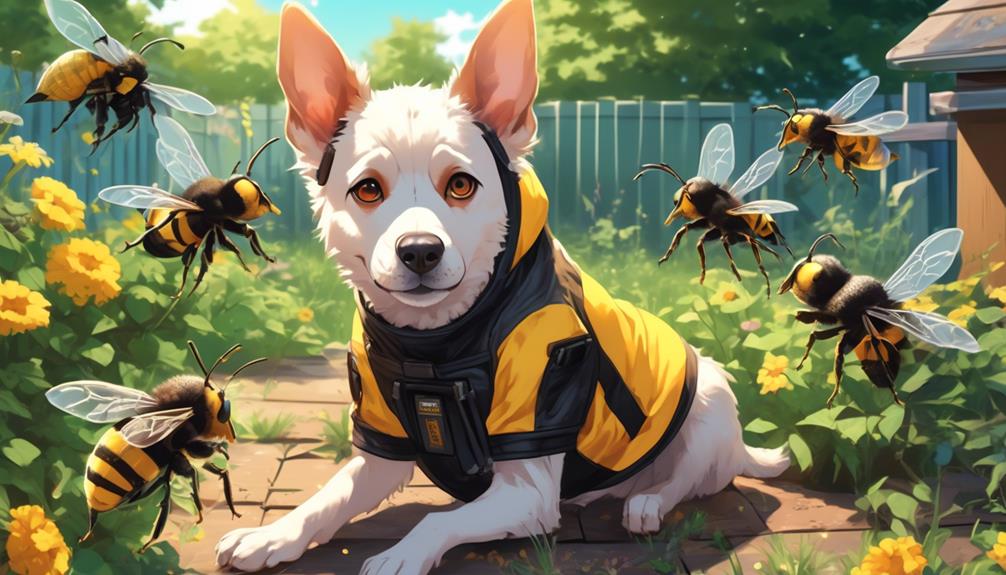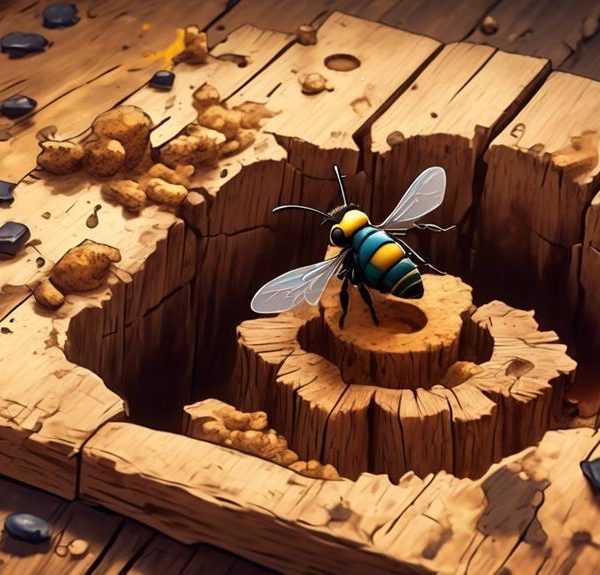Prevent painful encounters between your dog and carpenter bees with our effective tips while also learning how to handle any unfortunate stinging incidents.

Carpenter Bee Stung My Dog
While you might think that a carpenter bee, due to its large size and ominous buzzing, poses a significant threat to your dog, it's important to understand these creatures are generally non-aggressive and rarely sting. However, if your dog's curiosity gets the best of them and they decide to playfully paw or bite at one, it could lead to a painful encounter.
Now, imagine your pet yelping in pain, and you notice a carpenter bee flying away – what do you do? The steps you take next could make all the difference in your pet's recovery, but before that, wouldn't you want to know how to prevent such incidents in the first place?
Key Takeaways
- Carpenter bees are solitary creatures that excavate wood to build their nests.
- Female carpenter bees are the ones to watch out for as they can sting.
- Bee stings can cause immediate pain, redness, and swelling in dogs, similar to the reactions caused by carpenter bee stings.
- It is important to monitor dogs for signs of an allergic reaction and seek veterinary attention if symptoms persist or worsen.
Understanding Carpenter Bees

To fully grasp why a Carpenter Bee stung your dog, you first need to understand the nature and behavior of these intriguing insects. Carpenter bees are solitary creatures, meaning they live and work alone, and not in colonies like other bee species. They're called 'carpenter' because they excavate wood to build their nests.
Although they're large and intimidating, Carpenter bees are generally docile. The male, despite its showy aggression, can't sting. It's the female you need to watch out for. But even she isn't typically a threat unless provoked or feels her nest is in danger. She'll rarely leave her nest, spending most of her time laying eggs and caring for her offspring.
The Danger of Bee Stings to Dogs

While your dog's playful curiosity may lead them to encounter a Carpenter Bee, it's crucial to understand the potential danger posed by a bee sting to your canine companion. If your dog is stung, they'll likely experience immediate local pain, redness, and swelling. This is due to the bee's venom, which contains a variety of compounds designed to cause pain and deter predators.
In many cases, your dog's immune system can manage this localized reaction without any further complications. However, if your dog has an allergic reaction, the situation can become much more serious. Symptoms of an allergic reaction in dogs include swelling of the face, difficulty breathing, and vomiting. In extreme cases, anaphylactic shock can occur, which is a life-threatening emergency that requires immediate veterinary attention.
Although Carpenter Bees are less aggressive than other bee species, they'll sting if provoked, and their venom can cause the same reactions. Thus, it's important to monitor your dog's outdoor activities and discourage them from investigating these insects. Prevention is always the best form of treatment when it comes to bee stings.
Symptoms of a Bee Sting in Dogs

If your dog gets stung by a bee, you'll notice a range of symptoms that could potentially indicate a serious allergic reaction. Immediate signs include acute pain, characterized by yelping or whimpering. This is usually followed by redness, swelling, and a hot-to-touch area around the sting site. Your dog might also excessively lick or chew at the spot.
As the venom spreads, systemic symptoms might occur. These include drooling, dilated pupils, or a rapid heartbeat. You may also observe difficulty in breathing, disorientation, or even collapse, all signs of anaphylaxis, a severe allergic reaction.
However, symptoms aren't always immediate. Delayed reactions can occur 6 to 24 hours post-sting. These may manifest as lethargy, decreased appetite, fever, and generalized weakness.
It's crucial to monitor your dog's behavior post-sting. Any change in normal activity levels or behavior can be a sign of a more serious underlying issue. If symptoms persist or worsen, it's best to seek immediate veterinary attention. Remember, each dog's reaction to a bee sting can be different, and what might seem minor could escalate quickly if left untreated.
Immediate Actions to Take

Recognizing these symptoms in your dog post-sting, it's essential to act swiftly and decisively to mitigate any potential harm. First, remain calm as your anxiety can exacerbate your pet's stress levels.
Immediately locate the sting area and, if visible, remove the stinger. Use a flat-edged object, like a credit card, to scrape it out in a side-to-side motion. Avoid using tweezers, as they can cause the venom sac to burst, releasing more venom into your pet's system.
Next, apply a cold compress to the sting site to minimize swelling and numb the area, thus reducing pain. A mix of baking soda and water can also be applied as a paste to neutralize the venom.
Monitor your dog closely for signs of an allergic reaction such as difficulty breathing, excessive drooling, vomiting, or weakness. If these occur, transport your dog to a veterinary clinic immediately.
For mild reactions, consider giving your dog an antihistamine, but only under the guidance of a veterinarian. Remember, swift action can prevent complications, but always consult with your vet if you're unsure.
These actions can potentially save your dog's life and provide comfort in an otherwise uncomfortable situation.
Preventing Future Bee Stings

Guarding your pet against future bee stings involves understanding bee behavior, implementing preventive measures, and educating yourself on immediate response techniques.
Carpenter bees, unlike honey bees, are solitary creatures, generally not aggressive. However, they'll defend their nests if provoked. So, keep your pet away from areas where these bees nest, typically in wood structures.
Firstly, maintain your yard. Remove dead trees and prune overgrown vegetation, as these are ideal nesting sites. Regularly inspect outdoor furniture and decks for signs of carpenter bee activity.
Secondly, consider natural deterrents. Essential oils like citrus, peppermint, or tea tree, mixed with water, can be sprayed around likely nesting areas.
In addition, train your dog not to chase or disturb bees. It's crucial to understand that swatting at bees can provoke them, leading to stings.
Conclusion
So, your dog got stung by a carpenter bee.
It's critical to be aware of the potential danger and symptoms.
If your dog shows signs of a reaction, act immediately, seeking veterinary help if needed.
Prevention is key, so make steps to avoid future stings.
Stay informed about your local bee population and create a safe space for your pet.
Knowledge is power when it comes to protecting your four-legged friend.



